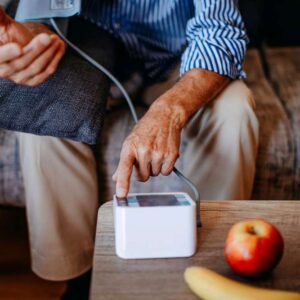
Tiny Toxic Threat Lurking in the Air You Breathe
Imagine taking a deep breath of fresh air, only to realize that—along with oxygen—you’re also inhaling tiny plastic particles.
It may sound like a scene from a science-fiction film, but new research reveals microplastics have found their way into the very air we breathe—and they may pose serious risks to your health.
Recently, scientists discovered that even wild dolphins are exhaling microplastic fibers. This startling finding underscores just how widespread plastic pollution has become.
But it’s not just dolphins at risk—we are breathing in microplastics, too, and the consequences could be devastating.
Microplastics are tiny plastic particles that are less than 5 millimeters in size. They come from the breakdown of larger plastic items like bottles, bags, and clothing.
Over time, plastics degrade into these tiny fragments, which then make their way into our environment—on land, in the water, and even in the air.
While many of us are familiar with the problem of microplastics in our oceans, the fact that we’re inhaling them through the air is less well-known. And that’s exactly what researchers found when studying dolphins in Florida and Louisiana.
These dolphins were exhaling plastic fibers similar to those found in human lungs.
Studies show that inhaling microplastics can lead to a range of health problems, including:
- Lung inflammation: When inhaled, microplastics can irritate lung tissues, leading to chronic inflammation. Over time, this can result in tissue damage, excess mucus production, and conditions like bronchitis or pneumonia.
- Scarring and lung damage: Microplastics can cause scarring in the lungs, similar to what’s seen in people with long-term exposure to dust or other pollutants. This scarring reduces lung function over time.
- Increased cancer risk: Studies suggest that long-term exposure to inhaled plastics could raise the risk of developing lung cancer. While more research is needed, this is a concern given how pervasive plastic pollution is.
It’s easy to assume that microplastics are only a problem for marine life, but the truth is they’re everywhere. You’re most likely being exposed to microplastics in your daily life through:
- Air: Microplastics can become airborne through wind or the action of ocean waves releasing them into the atmosphere. Once in the air, they can travel long distances and reach urban and rural areas.
- Food and water: Microplastics are found in various foods and beverages, including bottled water, seafood, and salt.
- Household dust: Plastics are present in everyday items like synthetic clothing, carpets, and packaging materials. As these items degrade, tiny plastic fibers are released into your home’s air, which you breathe in.
The idea of inhaling tiny plastic particles may feel overwhelming, but there are steps you can take to reduce your exposure:
Use an air purifier: A high-quality air purifier with a HEPA filter can help trap airborne microplastics and other pollutants, reducing the amount you breathe in at home.
Ventilate your home: Keeping windows open and using exhaust fans can help reduce the concentration of indoor pollutants, including microplastics.
Choose natural fabrics: Synthetic materials like polyester and nylon shed plastic fibers over time. Opt for natural materials like cotton, wool, and linen whenever possible.
Filter your drinking water: Install a water filter designed to capture microplastics, especially if you drink bottled water or live in an area with known water pollution.
Avoid single-use plastics: Reducing plastic consumption can help lower the demand for plastic production, reducing plastic pollution over time. Simple swaps like reusable bags, bottles, and containers can make a difference.
Microplastics have infiltrated nearly every aspect of our environment—from the oceans to the air we breathe. While research on their long-term health effects is ongoing, the evidence we have so far is enough to raise serious concerns.
Limiting your exposure to microplastics can help protect your health and reduce your contribution to this growing problem.
P.S. Are microplastics invading your gut barrier?
Source:
Dziobak, M. K., Fahlman, A., Wells, R. S., Takeshita, R., Smith, C., Gray, A., Weinstein, J., & Hart, L. B. (2024). First evidence of microplastic inhalation among free-ranging small cetaceans. PLOS ONE, 19(10), e0309377.
Written By Dr. Scott Olson, ND
Nearly 25 years ago, failed mainstream medical treatments left Dr. Olson in constant pain – and his health in ruins. And that’s when he did something REVOLUTIONARY. He began his career in medicine – and dedicated his life to uncovering the true, underlying causes of disease.
Through his innovative medical practices in Tennessee and Colorado, Dr. Olson has helped cure countless seniors from across America of arthritis… heart disease… diabetes… and even cancer. All without risky prescription drugs or painful surgeries.
View More Free Articles
Weird Tea Trick Calms Your Mind While Boosting Focus
You know the drill… If you want to feel more alert, coffee gives you the jolt you need. But when it’s calm that you seek, chamomile tea soothes you to sleep. But what if you could drink a beverage that can do both at the same time? A natural compound found in certain teas offers...
Can't Shake Negative Thoughts? Check Your GUT First
Everyone struggles sometimes to stay positive or see the bright side of things. It’s part of being human. You might think those negative thoughts start in your brain—but it’s more complicated than that. A simple change to your daily habit can help dial down those negative feelings. New research suggests that this simple strategy could...
Repair Your Gut Barrier With the “Sunshine Cure”
Happy Fourth of July! As you celebrate with sunshine, good food, and great company, don’t forget—those summer rays aren’t just lifting your spirits… they’re also working behind the scenes to protect your gut and boost your health. Your gut health is more important than most people realize. It directly affects your overall well-being—from immunity to...
The 5 Health Numbers Your Doctor Wishes You'd Track
Have you ever been told you should “advocate” for yourself when it comes to your healthcare and wondered what that really means? It’s not just a buzzword—it’s a powerful concept that empowers you to take charge of your own health journey. In fact, it could save your life. Being your own best health advocate starts...
Do THIS Every 20 Minutes to STOP Digital Eye Strain
Our eyes are under assault—they are the true victims of our current digital age. And it’s because we are constantly glued to screens… phones, tablets, computers, TVs—you name it. Unfortunately, that screen time is taking a serious toll. Digital eye strain affects millions worldwide. In fact, up to 50 percent of computer users could develop...
Mailbag: The Calcium Mistake That's Hardening Your Arteries
“What type of calcium is best to take with bisphosphonates for osteoporosis? I know some varieties can build up in arteries. Thanks for the help.” —Bone Builder Hi Builder, When a patient asks me about calcium, I ask them a peculiar question in return… “Ever wonder how elephants and giraffes build and maintain their massive...
Doctor-Approved Method to Ditch Blood Pressure Meds
In a world where drug solutions dominate healthcare, it’s refreshing to discover that best remedies sometimes don’t involve a single pill. A groundbreaking study shows simple relaxation techniques could be your secret weapon against one of America’s deadliest health conditions. Best of all? It’s free, easy to start right away—and your results are bound to...
Trouble Hearing? Your Heart Could Be at Risk
With research exploding and data pouring in, scientists are uncovering some weird (and surprisingly helpful) health connections. Today’s odd couple? Hearing loss and heart failure. Turns out your ears and your ticker are more connected than you ever imagined. A major study published in the journal Heart looked at over 164,000 people for nearly a...
Stay Up Late? It Could Destroy Your Mental Health
If you dread mornings but come alive at night, there’s concerning new research you need to know about. A recent study found that “night owls” are at higher risk for depression. But before you rush to set your alarm to get up with the sun tomorrow, there’s more to the story… Chronotypes are essentially your...
Go from Flabby to Fit with this Common Vitamin
If you’re like many of us, you woke up one day, looked in the mirror, and realized you’re no spring chicken anymore. Even worse—when you weren’t paying attention—it seems you somehow misplaced the muscles of your youth and have gone from fit to flabby. Aging has a way of humbling us like that. But scientists...









